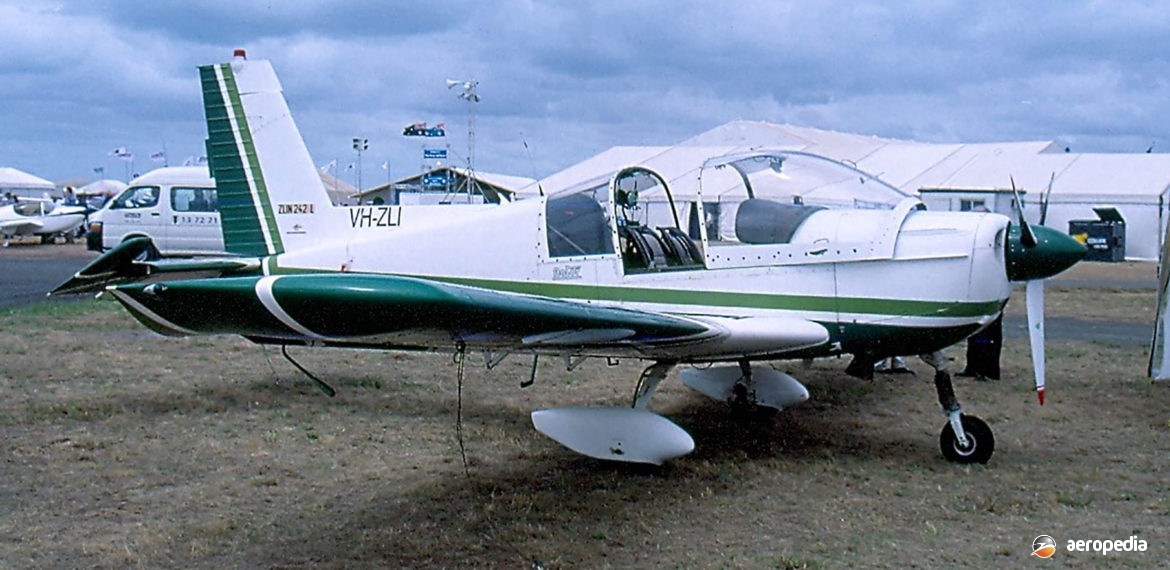Photograph:
Zlin 242L VH-ZLI (c/n 0658) at the Australian International Airshow at Avalon, VIC in 2001 (David C Eyre)
Country of origin:
Czech Republic
Description:
Two-seat training and sport monoplane
Power Plant:
One 149 kw (200 hp) Textron Lycoming ASIO-360-A1B6 four-cylinder horizontally-opposed air-cooled engine
Specifications:
- Wingspan: 9.34 m (30 ft 7 ¼ in)
- Length: 6.94 m (22 ft 9 ¼ in)
- Height: 2.95 m (9 ft 8 ¼ in)
- Wing area: 13.75 m² (148.09 sq ft)
- Max speed at 500 m (1,640 ft): 230 km/h (143 mph)
- Max cruising speed at 500 m (1,640 ft): 212 km/h (132 mph)
- Stalling speed flaps down: 93 km/h (58 mph)
- Max rate of climb at sea level: 258 m/min (845 ft/min)
- Service ceiling: 4,800 m (15,750 ft)
- Range at economical cruising speed at 500 m (1,640 ft): 1,035 km (643 miles)
- Empty weight: 730 kg (1,609 lb)
- Loaded weight: 1,090 kg (2,403 lb)
History:
Zlin began building gliders and small aircraft in 1934 but during World War II built Klemm 35B and Bucker Bestmann military trainers for the Luftwaffe. In 1946 it introduced the Zlin 26, the first of a new series of aerobatic aircraft which became known as the Trener. This was followed by the Z-126, which had a 78 kw (105 hp) engine, but was under-powered and was mainly used for glider towing. The next model was the Z-226 with a 119 kw (160 hp) engine which became the standard aircraft for the Czech aerobatic team and in the single-seat variant won many competitions. The Z-326 was made available in 1957 with a retractable undercarriage and was followed by the Z-526 with a 134 kw (180 hp) engine, the last of this series being the Z-726, production of the Trener series ending in 1977 after 1,500 examples had been completed.
The 242L was one of a series of aerobatic, training and touring aircraft designed by Zlin Aircraft at the Moravan Aeronautical Works Ltd. First in the series was the Z-42, which was followed by the developed Zlin 142, of which over 350 were built, this being exported to a number of countries. Design work on the Z-242 commenced in 1977, the prototype flying on 29 December 1978, power initially being supplied by the Avia M337AK six-cylinder in-line engine.
The 242L was a variant intended for the US market powered by a Textron Lycoming AEIO-360 engine driving a Muhlbauer MTV-9-B-C constant speed propeller, the prototype (OK-076) flying for the first time on 14 February 1990. This met with some success in the US, avionics usually being fitted from the Bendix/King Silver Crown range. Fuel capacity was 120 litres (26.4 Imp gals), but wingtip fuel tanks could be fitted bringing capacity to 230 litres (50.6 Imp gals). G limits in the touring category were +3.8/-1.5 and in the aerobatic role +6/-3.5.
The type was exported to a number of countries around the world, Canada’s Sault College at Barrie in Ontario obtaining seven for its flight training department. More than 75 were delivered to North American operators. One of the largest operators of the 242L was the Algerian Air Force, with 30 delivered.
Aerobatics could be performed and inverted flight was limited to one minute. The 242L differed from the Z-142 in having a re-designed engine cowling, front fuselage, wing and tailplane tips, a modified fuel system, and updated instruments. A spin recovery strake was installed on each side of the cowling. Accommodation was provided for two and a fixed tricycle undercarriage was installed.
First of the type seen in this region was OK-YNF (c/n 0658) with a Textron Lycoming engine, imported by the distributors Molokov Australia, which became VH-ZLI in January 1995. This aircraft was shown in February 1994 at the Singapore Air Show and was imported as a demonstrator before being sold. This was followed in August 1997 by VH-GCW (c/n 0541 – ex N1163V, SE-KMS) and VH-NZL (c/n 0651) operated by Aviator’s Beach Pty Ltd in the ACT.

